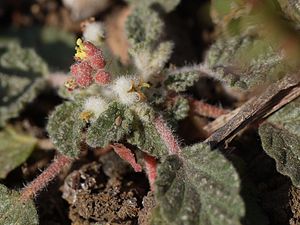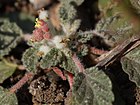Note: This is a project under development. The articles on this wiki are just being initiated and broadly incomplete. You can Help creating new pages.
Difference between revisions of "Chrozophora plicata"
(→References) |
|||
| (8 intermediate revisions by the same user not shown) | |||
| Line 1: | Line 1: | ||
[[File:Chrozophora plicata (Vahl) A.Juss. ex Spreng. (29096098190).jpg|thumb|right]] | [[File:Chrozophora plicata (Vahl) A.Juss. ex Spreng. (29096098190).jpg|thumb|right]] | ||
| + | '''Chrozophora plicata''' is a monoecious, annual to short-lived perennial herb. It grows up to 50 cm tall. The plant is harvested from the wild for local use as a medicine. | ||
==Uses== | ==Uses== | ||
| − | {{Uses|}}, {{Uses| | + | {{Uses|Jaundice}}, {{Uses|Wounds}}. |
==Parts Used== | ==Parts Used== | ||
| − | {{Parts Used|}}, {{Parts Used| | + | {{Parts Used|Fruits}}, {{Parts Used|Seeds}}. |
==Chemical Composition== | ==Chemical Composition== | ||
| − | <ref name="chemical composition"/> | + | The Alkali and Alkaline earth metal ions, mentioned previously were present in the powder of Chrozophora plicata leaves in small quantity. The amount of Lithium and Barium ions were present in Chrozophora plicata leaves more than sodium and calcium ions while potassium ions were present in small quantity.<ref name="chemical composition"/> |
==Common names== | ==Common names== | ||
| − | {{Common names|sa=|en=|gu=|hi=|kn=|ks=|ml=|mr=|pa=|ta=|te=}} | + | {{Common names|sa=|en=Betha, Okharad|gu=|hi=|kn=Linga Menasu|ks=|ml=|mr=|pa=|ta=|te=}} |
==Properties== | ==Properties== | ||
| Line 16: | Line 17: | ||
===Dravya=== | ===Dravya=== | ||
===Rasa=== | ===Rasa=== | ||
| − | |||
===Guna=== | ===Guna=== | ||
| Line 29: | Line 29: | ||
==Habit== | ==Habit== | ||
| − | {{Habit|}} | + | {{Habit|Annual}} |
==Identification== | ==Identification== | ||
===Leaf=== | ===Leaf=== | ||
| − | {{Leaf|||}}<ref name="Leaf"/> | + | {{Leaf|Dark publish brown||1.8-3cm Long, Grandular at base}}<ref name="Leaf"/> |
===Flower=== | ===Flower=== | ||
| − | {{Flower||||}} | + | {{Flower|Unisexual|5-6mm long||Borne in few flowered axillary racemes}} |
===Fruit=== | ===Fruit=== | ||
| − | {{Fruit||||||}} | + | {{Fruit|Capsule|||||Stallete wooly with silvary scales}} |
===Other features=== | ===Other features=== | ||
| Line 48: | Line 48: | ||
==Mode of Propagation== | ==Mode of Propagation== | ||
| − | {{Propagation|}} | + | {{Propagation|Seeds}} |
==How to plant/cultivate== | ==How to plant/cultivate== | ||
| Line 54: | Line 54: | ||
==Commonly seen growing in areas== | ==Commonly seen growing in areas== | ||
| − | {{Commonly seen|}}, {{Commonly seen|}}, {{Commonly seen|}}, {{Commonly seen|}}, {{Commonly seen|}}. | + | {{Commonly seen|Flood plains of rivers}}, {{Commonly seen|Along drainage channels}}, {{Commonly seen|Desiccating black clay soils}}, {{Commonly seen|Mudflats}}, {{Commonly seen|Sandbanks}}. |
==Photo Gallery== | ==Photo Gallery== | ||
| Line 64: | Line 64: | ||
<references> | <references> | ||
| − | <ref name="chemical composition">[" | + | <ref name="chemical composition">[https://www.helicsgroup.net/assets/articles/1589251048.pdf Chemical Composition]</ref> |
| + | |||
| + | <ref name="Leaf">Kappatagudda - A Repertoire of Medicianal Plants of Gadag by Yashpal Kshirasagar and Sonal Vrishni, Page No. 123</ref> | ||
| − | <ref name=" | + | <ref name="How to plant/cultivate">[Cultivation]</ref> |
| − | |||
| − | |||
</references> | </references> | ||
Latest revision as of 12:09, 29 April 2021
Chrozophora plicata is a monoecious, annual to short-lived perennial herb. It grows up to 50 cm tall. The plant is harvested from the wild for local use as a medicine.
Contents
- 1 Uses
- 2 Parts Used
- 3 Chemical Composition
- 4 Common names
- 5 Properties
- 6 Habit
- 7 Identification
- 8 List of Ayurvedic medicine in which the herb is used
- 9 Where to get the saplings
- 10 Mode of Propagation
- 11 How to plant/cultivate
- 12 Commonly seen growing in areas
- 13 Photo Gallery
- 14 References
- 15 External Links
Uses
Parts Used
Chemical Composition
The Alkali and Alkaline earth metal ions, mentioned previously were present in the powder of Chrozophora plicata leaves in small quantity. The amount of Lithium and Barium ions were present in Chrozophora plicata leaves more than sodium and calcium ions while potassium ions were present in small quantity.[1]
Common names
| Language | Common name |
|---|---|
| Kannada | Linga Menasu |
| Hindi | |
| Malayalam | |
| Tamil | |
| Telugu | |
| Marathi | |
| Gujarathi | |
| Punjabi | |
| Kashmiri | |
| Sanskrit | |
| English | Betha, Okharad |
Properties
Reference: Dravya - Substance, Rasa - Taste, Guna - Qualities, Veerya - Potency, Vipaka - Post-digesion effect, Karma - Pharmacological activity, Prabhava - Therepeutics.
Dravya
Rasa
Guna
Veerya
Vipaka
Karma
Prabhava
Habit
Identification
Leaf
| Kind | Shape | Feature |
|---|---|---|
| Dark publish brown | 1.8-3cm Long, Grandular at base |
Flower
| Type | Size | Color and composition | Stamen | More information |
|---|---|---|---|---|
| Unisexual | 5-6mm long | Borne in few flowered axillary racemes | {{{5}}} |
Fruit
| Type | Size | Mass | Appearance | Seeds | More information |
|---|---|---|---|---|---|
| Capsule | Stallete wooly with silvary scales |
Other features
List of Ayurvedic medicine in which the herb is used
Where to get the saplings
Mode of Propagation
How to plant/cultivate
Commonly seen growing in areas
Flood plains of rivers, Along drainage channels, Desiccating black clay soils, Mudflats, Sandbanks.
Photo Gallery
References
- ↑ Chemical Composition
- ↑ Kappatagudda - A Repertoire of Medicianal Plants of Gadag by Yashpal Kshirasagar and Sonal Vrishni, Page No. 123
- ↑ [Cultivation]
External Links
- [ ]
- [ ]
- [ ]
- Ayurvedic Herbs known to be helpful to treat Jaundice
- Ayurvedic Herbs known to be helpful to treat Wounds
- Herbs with Fruits used in medicine
- Herbs with Seeds used in medicine
- Herbs with common name in Kannada
- Herbs with common name in English
- Habit - Annual
- Index of Plants which can be propagated by Seeds
- Herbs that are commonly seen in the region of Flood plains of rivers
- Herbs that are commonly seen in the region of Along drainage channels
- Herbs that are commonly seen in the region of Desiccating black clay soils
- Herbs that are commonly seen in the region of Mudflats
- Herbs that are commonly seen in the region of Sandbanks
- Herbs
- Pages without herbs images

